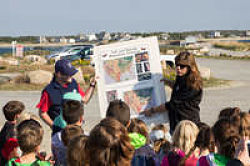Monarch Madness for Friends Academy Students
 By Lauren Zaknoun | Oct 09, 2015 | Dartmouth Week | Photos: Lauren Zaknoun
By Lauren Zaknoun | Oct 09, 2015 | Dartmouth Week | Photos: Lauren Zaknoun
If there’s anything kids love, it’s moving the classroom outside. Throw in butterfly nets, some unsuspecting monarch butterflies, and room to run, and you’ve got kids who are ready and excited to learn.
On the morning of Oct. 9, Friend’s Academy’s Gayle Balestracci and her third grade class made the trek to Gooseberry Neck Beach in Westport to seek out the last of the monarch butterflies.
“We’re doing a unit on Mexico, so we came on this trip because it ties in with their lesson,” Balestracci said.
Since September, monarchs have been migrating from Massachusetts to Mexico. It is now late in the season for those who still remain in the north.
Balestracci and the other 3rd grade teachers, Elizabeth Scholl and Kimberly Tavares, have been raising monarchs in their classes so the kids can see them grow and metamorphose in front of them.
Organized by the Lloyd Center for the Environment, Outreach Coordinator Liz Moniz provided the kids with some background on monarchs before heading out.
“Today, we’re all scientists,” she said to her young crowd.
The students were quite knowledgeable about monarch butterflies and Moniz filled in the blanks, quizzing kids on monarch factoids.
These expeditions can be hit or miss and, because it was late in the season, no one was sure if there would be a good turnout. Fortunately, the good weather was on their side, and the kids caught and tagged 10 monarchs.
The students were set loose to catch butterflies, many of them quite unsubtle in their excitement. After catching them, Moniz would help them tag the butterfly, identify its gender and record the information before releasing them again.
 From the minute they hatch, monarch caterpillars eat and continue eating, starting with the remains of the egg they hatch from. They grow rapidly and because they consume so much that their skin eventually pops off. Eighteen days into its lifecycle, the caterpillar will begin the metamorphosis process. It locks itself into a chrysalis for several days. When the monarch butterfly emerges from the chrysalis, its body is soft and vulnerable until its wings harden and it can fly.
From the minute they hatch, monarch caterpillars eat and continue eating, starting with the remains of the egg they hatch from. They grow rapidly and because they consume so much that their skin eventually pops off. Eighteen days into its lifecycle, the caterpillar will begin the metamorphosis process. It locks itself into a chrysalis for several days. When the monarch butterfly emerges from the chrysalis, its body is soft and vulnerable until its wings harden and it can fly.
Monarchs begin migrating from Mexico to Massachusetts in the spring. However, the migration takes many generations. Butterflies will fly from Mexico to the southernmost states, mate, lay eggs and die, and their babies will hatch, metamorphose and continue the journey. This happens again and again until they’ve reached New England.
More remarkable are the monarchs that migrate from Massachusetts to Mexico because they fly the entire trip—3,000 miles—in one go. The journey is very trying and vast amounts of monarchs do not survive it. They ascend to a distance of 11,000 feet above the ground—about two miles—as they migrate south.
For the winter, they survive in Mexico’s oyamel trees where hundreds of monarchs cluster together for warmth at night until spring comes again.
But why is there such a fascination surrounding monarch butterflies? Why is it that so many schools gravitate around monarchs and teaching kids about their migration patterns?
“It lends itself to elementary education for students to learn about insects, to learn about migration, [and] different aspects of habitat,” said Moniz. “It ties in really well specifically with Massachusetts standards and what students should be learning in elementary school.”

